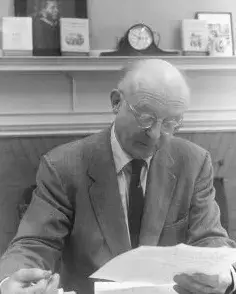Howard Mumford Jones was president of the American Academy of Arts & Sciences from 1944 to 1951. He was a Pulitzer Prize-winning author and cultural critic who played a leading role in the Academy's transformation into a national organization dedicated to the interdisciplinary analysis of broad-scale intellectual issues.
In his inaugural address, he shared his understanding of the declining relevance of academies in general: “No one can say, I think, that in 1900 academies were as important in the total intellectual life of a nation as they had been in 1800 or in 1700. All the forces leading to the fractation of knowledge have been more vigorously operative in the last forty years than ever before.”
However, Jones found that all the specialization that had given rise to universities and laboratories had, in a way, “defeated itself.” He explained that “what once looked like a separate compartment of knowledge, unique and apart from everything else, the more it is explored, the more its boundary lines seem to waver and vanish. The relation of fields is not that of pigeon-holes, but of living, interdependent cells.”
He shared his vision for the Academy undertaking interdisciplinary work as he asked “what knowledge is to be intercommunicated, and where can this intercommunication best take place?” To help answer that question, Jones called for a Commission tasked with writing a report “of such depth and magnitude as will bring immediately home to each of us the problem of the Academy and its future in a world that may seem to have outgrown these primitive institutions.”
The Commission, chaired by Kirtley Fletcher Mather, completed their report in 1946. Among its recommendations were enlarging the membership and increasing the proportion of nonresident Fellows, changing the character of the Academy's Proceedings (now Daedalus), and initiating interdisciplinary symposia and conferences.
“A Remembrance of Howard Mumford Jones” - published in the Bulletin upon his death in 1980 - ended with the recognition that he “lived to see many of the changes he had envisioned carried out by the Academy.” And many continue to define the Academy and its work to this day.
